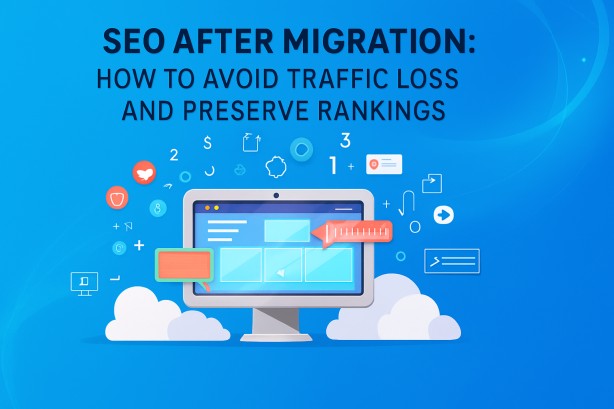


This guide shows how to manage SEO after migration and prevent ranking drops, traffic loss, and visibility issues.
Website migration can revamp your digital presence—especially for eCommerce brands upgrading platforms, improving performance, or redesigning their site. But while these changes often deliver long-term benefits, they come with a serious short-term risk: SEO and organic traffic loss.
If your SEO isn’t handled properly during migration, rankings can drop, traffic can vanish, and sales can decline—sometimes dramatically. Fortunately, you can avoid that outcome with careful planning and execution.
Search engines rely on consistency to understand your site. A migration disrupts that in several ways:
Each of these issues can confuse Google, resulting in lost rankings—even for high-performing pages.
Knowing the type of migration helps tailor your SEO plan. The most common include:
Each scenario affects SEO differently but all require strategic handling to preserve rankings.
Before anything changes, gather data on your current SEO performance:
This becomes your reference point for the new site and helps you spot and fix issues quickly.
Redirects are crucial. A 301 redirect tells search engines a page has permanently moved and transfers ranking power.
Mistakes here can result in traffic drops or lost link equity.
During design changes, it’s easy to lose critical SEO components. Make sure to:
These elements help Google understand and index your content correctly.
After launching the new site:
This helps search engines crawl your new structure faster and more accurately.
Watch key metrics closely after launch:
Review daily in the first week and weekly after that. Catching issues early can prevent long-term SEO damage.
If internal links still point to old URLs, users may encounter errors or unnecessary redirects.
Clean internal linking improves both SEO and user experience.
If the migration includes a domain change, use Google’s Change of Address Tool in Search Console.
Also, let users know:
Keeping users and search engines informed builds trust and speeds recovery.
Migrations involve technical decisions, SEO strategy, and ongoing performance tracking. An experienced eCommerce migration service can manage:
This ensures a smooth transition while preserving your search visibility and revenue.
Website migration doesn’t have to mean SEO disaster. With the right steps—careful planning, precise redirects, on-page optimization, and post-launch monitoring—you can maintain or even improve your search performance.
Whether you’re upgrading platforms, changing domains, or restructuring your site, treating SEO as a top priority ensures your investment pays off.
